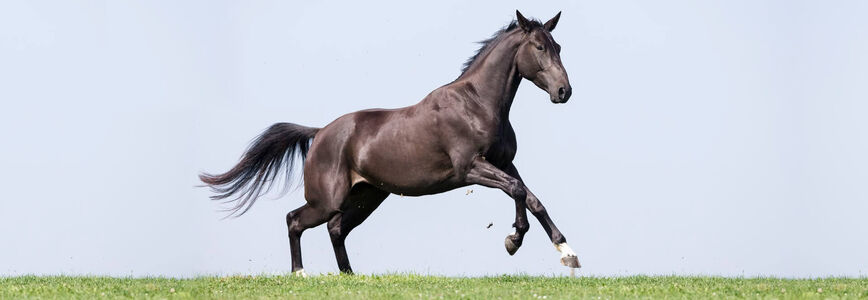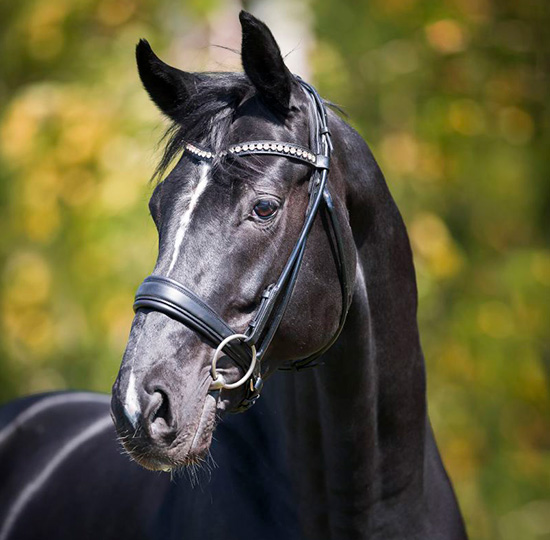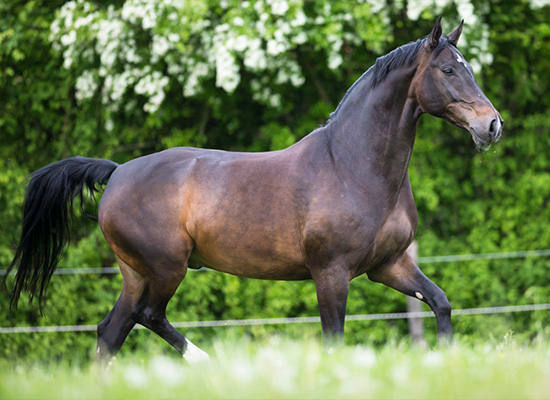
Hanoverian stallions have an athletic physique that makes them outstanding dressage and jumping horses.
Breed:
Hanoverian horse
Group:
warm-blooded horses
Height at the withers:
160 - 185 cm
Apperance:
rectangular body, strong legs, elegant head with large eyes and long ears, muscular neck and sloped shoulders
Colour of coat:
chestnut, black, brown, white
Character:
uncomplicated, good-natured, eager to learn and with strong nerves
Gait:
graceful and elegant, spirited, expansive movements
Origin:
Stud farm Celle, Lower Saxony
Prevalence:
worldwide
Suited for:
jumping, dressage, carriage driving
Did you know? Due to their success in tournaments, Hanoverian stallions as well as mares and foals can be quite expensive. In addition to the well-known Hanoverian stallion selection, the Hanoverian Association also hosts an auction in Verden once a year. The most expensive horse to be auctioned was worth 2.1 million euros.

Outstanding jumping and dressage horses: Hanoverians.
The Hanoverian horse breed is the warm-blooded horse breed with the most horses in Europe. The athletic riding horses are considered the most successful sport horses when it comes to dressage and jumping. They continue to achieve outstanding results at world championships and Olympic Games. They are easy to ride, have great basic gaits and a well-balanced nature. The breed was created in the 16th century. Farmers in the Hanover area bred these horses for agricultural work and the military. In 1735, George II., King of Great Britain and Ireland, who comes from the House of Hanover, founded the Stud Farm of Lower Saxony in Celle. The stud that still exists today was where the breed was first centrally registered. Since 1922, the breeding register has been with the Hanoverian Association in Verden. Over time, the Hanoverian breed was refined by crossbreeding English thoroughbreds and Trakehner horses. Especially after World War II, horses were used less and less for work. Thus, there was an increasing focus on breeding reliable sport horses and horses for recreational riding.

Their friendly and approachable nature makes them very popular among riders.
You can tell from the first look that Hanoverians are athletic horses. Their muscles are well-developed, and they have a rectangular frame. And to go with the muscular physique, they have exceptionally strong legs. Despite their well-developed muscles, these warm-blooded horses have a dry, elegant head with long ears and large nostrils. Their open eyes and their friendly gaze are especially beautiful. Horses of this breed can vary in size. Breeders aim for 1.65 m at the withers. In general, there are Hanoverians in all colours, but brown and chestnut-coloured horses are most common. You will also often see white marks in this breed. Riders love their elegant and harmonious basic gaits. They make Hanoverians successful as dressage horses as well as easy to ride as recreational horses. Their friendly and approachable nature also makes them very popular among riders. Their well-balanced nature developed in times when horses were still deployed in the military service. After all, as military horses, they had to be well-balanced and fearless. And they still have these traits today. In addition, Hanoverians are extremely eager to learn, they are intelligent and hard working.
The gelding “Gigolo” and the stallion “Goldfever” are among the most well-known Hanoverians. With “Gigolo”, Isabell Werth won a gold medal in dressage for Germany during the Olympic Games. “Goldfever” is a very successful jumping horse owned by Ludger Beerbaum and is now used for breeding.